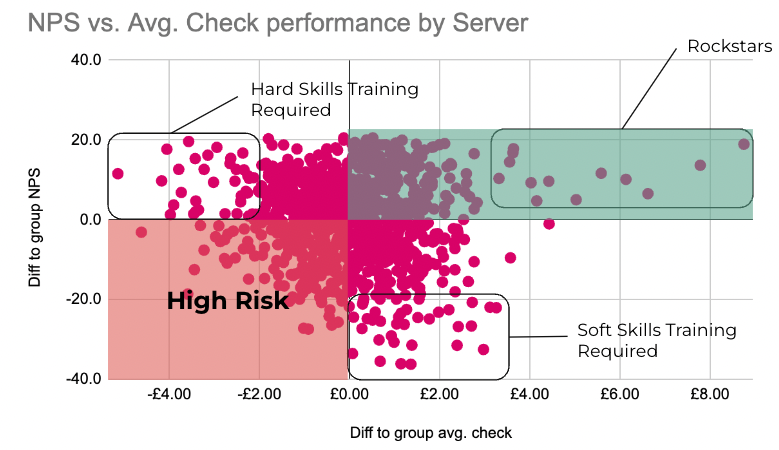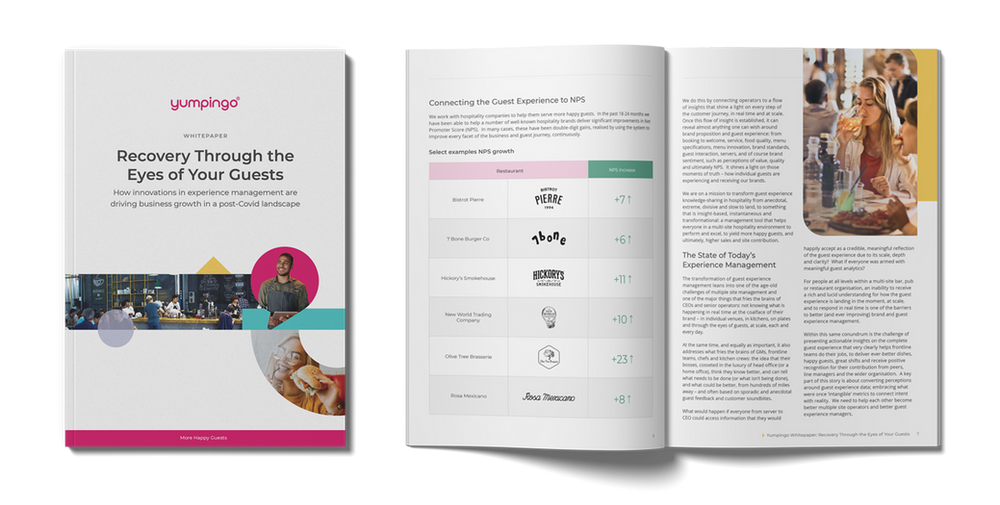
The solution to better brand experiences is to go above and beyond for your guests, but effective upselling or recommendations are the next best thing. Matt Holy, our Director of Strategic Projects delves into the server-level tipping data to showcase how guest sentiment actually affects tipping in the US and sustainable ways that teams can improve tips while enhancing the guest experience.
****
One of my first jobs in the industry was as a server at a breakfast & lunch-focused restaurant in downtown Montreal. Speedy service was the name of the game there. Our prime service window was short, so the faster that we could turn our tables, the better.
This regrettably was not my strong suit. I would happily oblige in conversation with chatty guests whenever the opportunity arose. While this was a part of serving tables that I genuinely enjoyed, I was also of the belief “friendly” service was the key to higher tips. I would later learn that this philosophy meant I was leaving money on the table.
"Watching [the top servers] navigate the dining room was like watching a figure skater in the rink. Every movement was intentional and timed to perfection. Not a second was ever wasted."
At the end of the shift, servers in the restaurant would regularly compare tips during cash out. While I rarely had the most tips in a shift, I started to notice an interesting trend about the servers who were regularly amongst the top performers. They were seasoned, efficient, upselling machines. Watching them navigate the dining room was like watching a figure skater in the rink. Every movement was intentional and timed to perfection. Not a second was ever wasted.
That being said, I also found something very mechanical, almost robotic, about how these servers interacted with guests. Table touches seemed purely transactional instead of focussed on building rapport. Was there anything that could be done to go above and beyond to enhance their experience? It didn’t matter. Once payment was made, the interaction with that guest was over and the server would quickly move on to the next table.
"While guests who had a great experience (5/5) tipped an average of 19.38% on their bills, guests who had a terrible experience (1/5) only tipped marginally less at 19.02% (on average)."
Is this really what great service means to guests? Do they actually appreciate genuine hospitality or has tipping morphed into a mostly transactional interaction?
Digging into the data, the answer to this is quite surprising.
The big picture
To answer this question, I started diving into system-wide Yumpingo data against POS data to analyze tip percentages against Net Promoter Scores (NPS). This dataset comprised over 1 million guest checks across hundreds of full service restaurants in 48 states across the US (2023). The percentage difference in tips against each NPS rating? Negligible.
While guests who had a great experience (5/5) tipped an average of 19.38% on their bills, guests who had a terrible experience (1/5) only tipped marginally less at 19.02% (on average).
Interestingly, there was also virtually no difference in tips received from guests who had neutral experiences (4/5) compared to a great experience (5/5).
"We discovered that servers who were effective in this area had average checks as much as 15% higher than those who weren’t."
While this data does demonstrate that guests who receive a better experience do tip more, albeit marginally, a much bigger difference on overall tip earnings is actually linked to a server’s ability to cross-sell and upsell effectively.
Diving deeper
In examining Yumpingo data on cross-selling steps of service (like offering snacks to start or dessert menus at the end of the meal), we discovered that servers who were effective in this area had average checks as much as 15% higher than those who weren’t. Even more interesting is that these guests were typically much happier as a result of being offered the right item at the right time.
In an example from one of Yumpingo’s customers below, you’ll see that guests who were simply given dessert menus had average checks that were about 5% higher than those who weren’t. These guests not only spent more money in the restaurant, but left significantly happier, with a NPS nearly 40 points higher than guests who were not offered dessert menus.
Now this all sounds great. As a restaurateur in the full service restaurant space, it seems as though cross-selling is the key to creating a win-win-win scenario.
- Win for your customer since they typically leave happier when cross-sold.
- Win for your FOH team since cross-selling results in a higher average check, and ultimately a higher tip as a result.
- Win for the restaurant since cross-selling drives more sales.
But there’s a catch.
If cross-selling is done ineffectively, or perhaps a little too aggressively, it could drive your customers away from your business for good.
When looking at sales data relative to NPS at the server level, it becomes quite clear that cross-selling alone is not the key to running a sustainable business.
The below chart dives into this in a little more detail, looking at server NPS performance relative to average check for one of Yumpingo’s customers. Plotting each server against the median for both categories has them landing in one of 4 quadrants:
- High Sales, High Guest Satisfaction
- High Sales, Low Guest Satisfaction
- Low Sales, High Guest Satisfaction
- Low Sales, Low Guest Satisfaction

In an ideal world, all of your staff would be excellent at driving guest satisfaction AND average check, but the reality is that only about 20% of your servers typically land in this category. That means about 80% of servers are either leaving money on the table or driving guests not to return to your restaurant (or both).
Because of this, it’s crucial to be able to identify which team members land in each quadrant. This will allow you to celebrate your rockstars (and even use their expertise as best practice) while being able to give the right coaching to your team members that require training on hard or soft skills during service.
Closing thoughts
In identifying that tip percentages are relatively stable, regardless of how much guests enjoyed their experience, you could argue that a system designed to incentivize great service has morphed into a system that incentivizes driving average checks and turning tables quickly. The data certainly suggests that the same types of servers who were successful in the restaurant I first worked at are still getting the most tips.
That being said, the data also suggests that in order to truly be a “rockstar”, an element of genuine hospitality is still required. While increasing average checks can have great short-term benefits for the server and for the restaurant, this alone will not keep your guests coming back again and again.
Anyone can suggest the most expensive dish on the menu, but a “rockstar” will read their table and suggest the right items at the right time to the right people. It’s about adding value to your guests, not simply adding value to their check.
While finding this balance may be tricky, especially for servers who are in it for the short-term reward of tips, our guests will thank you in the long run by becoming some of the best brand advocates you could ask for.
The outcome must be to encourage upselling in a way that enhances guest sentiment.



